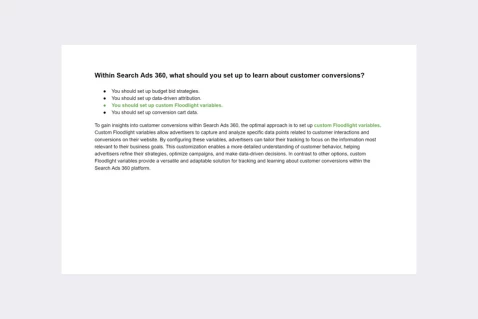You learn from your customer, a hat designer, that they just updated their campaigns to reflect new audience targets for a new line of bowlers and fedoras. Within their Search Ads 360 campaign, how can they keep track of those changes?
By using segments
By using labels
By using conversion columns
By using templates
Certification program: 👉 Google Search Ads 360 certification exam
Explanation: To effectively keep track of changes in their Search Ads 360 campaign reflecting new audience targets for a new line of bowlers and fedoras, the hat designer can utilize the option of “using labels”. Labels in Search Ads 360 provide a flexible and efficient way to categorize and identify specific elements within campaigns, such as ads, ad groups, or keywords. By applying labels to the updated campaigns related to the new audience targets, the hat designer can easily filter and monitor the performance of these specific elements. This allows for streamlined tracking and analysis, ensuring that the impact of the changes is closely monitored, and adjustments can be made as needed to optimize the campaign for the newly targeted audience.
Passing exams is not a workout. Multiple attempts won’t make you stronger.



- All possible Search Ads 360 certification exam questions with answers, and explanations.
- Real certification exam questions
- Detailed answer explanations.
- Reflects exactly the latest real exam questions.
- Free lifetime updates.
Tracking Audience Target Updates in Search Ads 360 Campaigns
For a hat designer launching a new line of bowlers and fedoras, keeping track of audience targeting updates is crucial to ensure that their advertising campaigns effectively reach and engage their target audience. With Search Ads 360 (SA360), designers can easily monitor changes to audience targeting settings and optimize their campaigns for maximum impact.
Understanding Audience Targeting in SA360
Audience targeting in SA360 allows advertisers to define specific audience segments based on demographics, interests, behaviors, and more. By targeting relevant audiences, advertisers can increase the effectiveness of their campaigns and drive better results.
Tracking Audience Target Updates
Here’s how hat designers can keep track of audience targeting updates in their SA360 campaigns:
1. Audience Segmentation
In SA360, designers can create audience segments based on criteria such as gender, age, interests, or past purchase behavior. By segmenting audiences effectively, designers can tailor their ad messaging and creative assets to resonate with each audience segment.
2. Audience Insights
SA360 provides valuable insights into audience performance, including metrics such as click-through rates, conversion rates, and return on ad spend (ROAS). By analyzing audience performance metrics, designers can identify which audience segments are driving the best results and adjust their targeting accordingly.
3. Change History
The Change History feature in SA360 allows designers to track any changes made to their campaigns, including updates to audience targeting settings. By reviewing the change history regularly, designers can stay informed about any updates or adjustments made to audience targeting and understand their impact on campaign performance.
4. Custom Alerts
SA360 offers custom alert functionality, allowing designers to set up alerts for specific changes or performance thresholds. Designers can create custom alerts for audience targeting updates, ensuring that they are notified promptly whenever changes are made to audience segmentation or targeting criteria.
Practical Insights for Designers
Here are some practical insights for hat designers looking to track audience targeting updates in their SA360 campaigns:
-
Regular Monitoring: Make it a habit to regularly monitor audience performance metrics and review the change history in SA360 to stay informed about any updates or adjustments to audience targeting.
-
Experimentation and Optimization: Continuously experiment with different audience segments and targeting criteria to find the most effective combination for reaching and engaging your target audience.
-
Data-Driven Decision Making: Base audience targeting decisions on data-driven insights and performance metrics to ensure that your campaigns are optimized for success.
-
Collaboration and Communication: Foster collaboration and communication between marketing teams to ensure that everyone is aligned on audience targeting strategies and updates.
By leveraging the tools and features available in SA360 and following these practical insights, hat designers can effectively track audience targeting updates and optimize their campaigns to reach and engage their target audience effectively.
Remember, success in digital advertising requires a combination of strategic planning, data-driven optimization, and continuous monitoring and adjustment to stay ahead of the competition and achieve your advertising goals.
Discover our best-value guides
- Special Bundle Offer Google_Ads_Roll
- Special Bundle Offer HubSpot_Exams_Roll
- Special Offer Unchained_Guru_Roll
- Special Bundle Offer Amazon_Roll
- Special Bundle Offer Google_Analytics_Roll
- Special Bundle Offer Google_SkillShop_Roll
- Special Bundle Offer Marketing_Platforms_Roll
- Special Bundle Offer Microsoft_Advertising_Roll
- Special Bundle Offer YouTube_Roll
- Special Bundle Offer Google_Android_Roll
- Ultimate PMP certification preperation guide
- Google Cloud Professional Architect Certification Exam Answers - Ultimate Guide
- Special Bundle Offer SEMrush_Roll